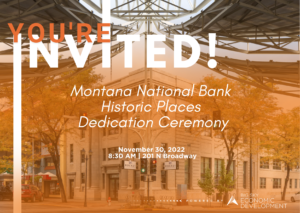
Join BSED in honoring the Montana National Bank, listed in the National Register of Historic Places by the United States Department of Interior in cooperation with the Montana Historical Society.
EVENT DETAILS:
We will gather in the Zoot Training and Event Space at 201 N Broadway for remarks from BSED, a short presentation from Kevin Kooistra with the Western Heritage Center on the history of the building and its significance to Billings. Following the presentation will be the plaque unveiling outside of the building. Coffee and breakfast pastries will be provided.
The Montana National Bank building stands at the northeast corner of the prominent Broadway and Second Avenue North intersection at the core of downtown Billings’ central business district. An important anchor in this area of downtown, its construction in 1918 coincided with the expansion of the commercial area north from its origins near the railroad tracks, which run two and a half blocks to the south. The building functioned as a financial center for nearly 100 years, and played a key role in the growth of commerce and culture in the city. The three-story plus basement, tan brick masonry property retains significant details associated with its original Neoclassical Revival design by Omaha-based Architect George B. Prinz. Terra cotta elements emphasize the stylistic features, including a full-height monumental entry set off by Ionic columns; an elaborate, dentilled cornice; and balustraded parapet. In addition to the terra cotta, limestone, granite, and marble feature prominently at the water table, bases, and sills. Remodeled and expanded in 1952, a three-story brick International-style addition extends from the original building’s east (rear) elevation. Billings architects Orr Pickering & Associates chose mid-century modern steel-framed windows to fill the original openings as well as those in their addition. An interesting melding of classical and modern elements, the bank building continues to convey its historic and architectural significance.

